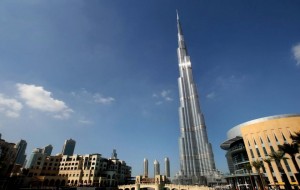By Kevin Brass www.thenational.ae
When the Burj Khalifa opened a year ago in a blizzard of lights and fireworks, it was hailed as the new champion among the world’s tallest buildings. But the 828-metre tower is simply the latest leader in a never-ending quest to reach for the sky.

The past decade was something of a golden era for skyscraper construction. Seven of the 10 tallest buildings were built from 2004 to last year, including six in the past three years.
The past year, though, set new standards for opulent heights, with the completion of a flurry of skyscrapers started in the economic boom years. At the beginning of last year, Dubai’s 355-metre Emirates Tower One was the 10th tallest building; now it is 20th.
“Never before were so many tall buildings and heights being realised as in 2010, and a lot more are still being planned to be completed in the next couple of years,” said Jan Klerks, a spokesman for the Council on Tall Buildings and Urban Habitat (CTBUH), a group in Chicago that tracks the skyscraper race.
Last year’s list of new towers includes the 484-metre International Commerce Center in Hong Kong, the fourth-tallest building in the world; the 450-metre Nanjing Greenland Financial Center in Nanjing, China, the seventh-tallest; and the 438-metre Guangzhou Financial Center, number nine on the list.
While the Burj Khalifa grabbed the top spot last year – surging past the 508-metre Taipei 101, which was topped off in 2004, and the Shanghai World Financial Center, a 492-metre hotel and office tower completed in 2008 – Asia is leading the new generation of super-tower construction.
“If you look back 20 years ago, most of the tall buildings were in North America, mostly steel construction and typically one-function buildings,” said Bill Maibusch, the project director for Turner Construction International and the country representative in Qatar for the CTBUH.
“The trend now is most tall buildings are in Asia and the Middle East, most are concrete and most are mixed use.”
But Asia and the Middle East are not alone in the competition. Towers are also going up in Russia, Panama and Australia.
The heights might not be as giddy as in China and Dubai, but London has four buildings under construction that will be taller than the city’s existing tallest building, the 235-metre-tall One Canada Square in Canary Wharf. The tallest will be the 310-metre, Renzo Piano-designed Shard of Glass, which is scheduled for completion next year.
Trying to explain the reasons for this surge in tall buildings is difficult. At one point, skyscrapers were seen as an efficient use of urban space, but the economics can no longer justify the new heights. Once towers rise above 50 or 60 storeys, the costs escalate dramatically. Forces beyond economics are at work, experts say.
“Part of it is ego,” Mr Maibusch said. “Part of it is creating an iconic tower that stands apart from others.”
Interest in tall buildings goes far beyond the realm of architects and engineers. Fan sites and magazines devoted to skyscrapers include skyscrapernews.com, emporis.com, skyscraperpage.com and skyscrapercity.com.
There has always been this fascination about tall buildings, Mr Maibusch said. “It’s the level of what mankind can achieve.”
The economic downturn has barely slowed the pace of the competition.
Towers under construction in China include the 632-metre Shanghai Tower, the 600-metre Ping An International Finance Center in Shenzen and the Goldin Finance 117, a 597-metre project in Tianjin.
The tallest building currently under construction is Mumbai’s India Tower, a 720-metre tall, residential, office and hotel complex due for completion in 2016.
The 601-metre Royal Mecca Clock Tower in Saudi Arabia and the 414-metre Princess Tower in Dubai, billed as the tallest residential tower in the world, should both be completed in the next year.
Four buildings have been proposed that would surpass the Burj Khalifa – all in the Middle East. But all are categorised by the CTBUH as stalled.
decade.
Going higher is “doable”, said Eric Tomich, the associate director of the Dubai office of Skidmore, Owings and Merrill, the architects behind the Burj Khalifa.
Technology is not an issue, Mr Tomich said. The Burj Khalifa demonstrated that it is possible to tackle such issues as pumping concrete to 600 metres and designing towers to resist the wind. And lifts can cope with the great heights.
“We haven’t hit any limits on height,” Mr Tomich said. “The limits are still economic ones.”












